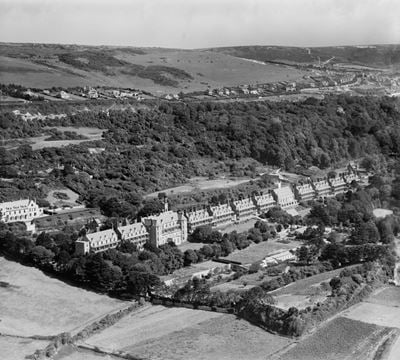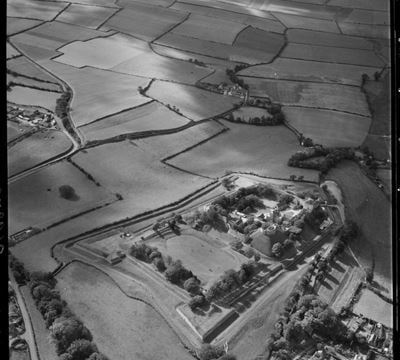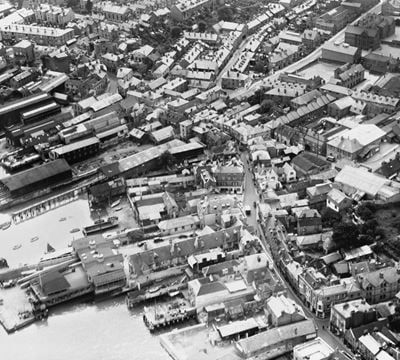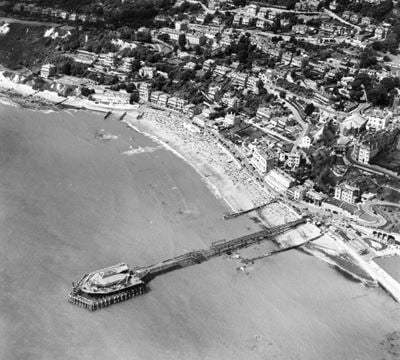Isle of Wight
Explore hidden histories, historic photos, and things you never knew about Isle of Wight from the collections and archives of Historic England.
Discover your local listed buildings and places
Introducing some of Isle of Wight's most historic sites, included in the National Heritage List for England. Some of these captions have been summarised by AI. Click through for the official List entry. Skip this section and go to place by numbers
Former Ventnor Radar Station Receiver site and remnants o…
Ventnor
Surviving components of the Ventnor Radar Station, 1938-9, comprising an Rx receiver building, three receiver tower bases, one modified with the addition of a VEB (Variable Elevation Beam)...
Appuldurcombe House and Freemantle Lodge Gateway
Godshill
Appuldurcombe House, an English Baroque masterpiece in the 18th century, offers archaeological insights and features Capability Brown gardens.
Westover
Calbourne, Newtown and Porchfield
Westover is an 18th-century country house on the Isle of Wight, transformed in the early 19th century by Sir L T Worsley Holmes.
Shingles Bank Wreck NW96
Needles Channel, Isle of Wight
The site comprises a late C15 or C16 wrecked merchant vessel, which includes seabed remains of its cargo, together with stone cannon balls.
Nunwell
Brading
Nunwell, historically held by the King at Domesday, became known through the Oglander family from the 12th century, retaining estate gardens and pastures developed over successive centuries.
Brading Roman villa
Brading
Brading Roman villa exemplifies high-status Roman architecture, featuring elaborate mosaics and advanced heating systems, tracing the historical evolution from Roman to early medieval times.
Norris Castle
East Cowes
Ornamental pleasure grounds and park laid out from c1799, possibly by Humphry Repton, as a landscaped setting for a marine villa built in the form of a Gothic castle designed by James Wyatt,...
Bouldnor Battery
Shalfleet
Bouldnor Battery was part of England's coastal defense from the 15th to the 20th century, with two gun emplacements protecting the Solent's entrance.
Unknown Wreck off Thorness Bay
0.59km south-west of Gurnard Ledge, Thorness Bay, Isle of Wight.
The remains of a wooden sailing vessel located in shallow water off the Isle of Wight.
Osborne
East Cowes
Osborne was the family home of Queen Victoria and Prince Albert from 1845 to 1901. Prince Albert designed and landscaped the estate, including pleasure grounds and a park.
Bembridge Fort
Bembridge
Bembridge Fort, a Royal Commission fortification, exemplifies 19th-century coastal defenses, playing a key role in Britain's national defense.
201 & 203, York Avenue
East Cowes
A semi-detached pair of concrete houses of 1852, architect unknown, but probably designed by their builder Richard Langley; shuttered concrete wall construction using cement from the local...
12, 13 and 14 Anglesea Street
Ryde
Terrace of three cottages, early C19 , including a mid-C19 shopfront.
Church of St Boniface (Old Church)
Ventnor
C12 nave and C13 chancel. The west bellcote is of c.1830. The church was restored by Percy Stone in 1923 and 1931.
Appuldurcombe
Godshill
A late C18 landscape park laid out to a design by Lancelot Brown around a C17 and C18 house which was altered in the early-mid C19 by the addition of ornamental pleasure grounds forming an...
The Needles Site
Totland
The Needles site contains remains of the Assurance and HMS Pomone wrecks from 1753 and 1811, respectively, along with maritime artifacts from other vessels.
The Guildhall
Newport and Carisbrooke
Guildhall, originally consisting of a market hall, town-hall chamber and council chamber, built between 1814 and 1816, design by the architect John Nash, clock tower built between 1887 and...
Hammerhead Crane at J S White Shipyard
Cowes
Giant Cantilever Crane, also called 'hammerhead' crane, built 1911.
Carisbrooke Castle
Newport and Carisbrooke
Carisbrooke Castle, with origins in the 11th/12th centuries, was where Charles I was imprisoned. His daughter, Princess Elizabeth, died there and is buried nearby.
Norris Castle Farm, the bailiff’s house, cottage and wall…
East Cowes
Model farm with attached bailiff's house, workers' cottage and walled garden. Built c1799 by James Wyatt for Lord Henry Seymour.
Yarmouth Roads
Yarmouth Roads, off Yarmouth, Isle of Wight
The Yarmouth Roads wreck, possibly the Spanish carrack Santa Lucia from 1567, features Mediterranean construction with artefacts tied to the triangular trade with England and the Low...
Ventnor Botanic Garden
Ventnor
Ventnor Botanic Garden, part of a former chest hospital, opened in 1972 with plant collections from Sir Harold Hillier. It covers 10 hectares on Isle of Wight.
Former Ryde Town Hall
Ryde
Former town hall and market house built between 1829 and 1831, designed by James Sanderson.
Bathing House and a 50m length of raised sea wall at Norr…
East Cowes
Lodge and bath house with attached raised sea wall, early C19, for Lord Henry Seymour.
Bembridge Windmill
Bembridge
Bembridge Windmill, built around 1700, features early 18th-century machinery and was sketched by JMW Turner in 1795. It was operational until 1897 and is now managed by the National Trust.
Holy Trinity Church
Ventnor
1861-2 by C E Giles of Taunton. Some furnishings introduced from 1891 by Charles Barker King.
Carisbrooke Castle: a shell keep castle on the site of a …
Newport and Carisbrooke
Carisbrooke Castle is a notable shell keep on the Isle of Wight, renowned for its role in Charles I's confinement and featuring well-preserved 16th-century fortifications.
Round barrow cemetery on Brook Down known as 'Five Barrows'
Brighstone
The round barrow cemetery on Brook Down dates to the Bronze Age, containing nine barrows and offering insights into prehistoric beliefs and social organization.
The Royal Victoria Arcade
Ryde
Shopping arcade, 1835-6 by William Westmacott, including a contemporary ice well.
Church of St Peter
Nettlestone and Seaview
Between 1859-62 Thomas Hellyer of Ryde built the nave, north aisle and a small chancel. The chancel was enlarged and the north vestry built c.1871.
The Shanklin Theatre and Former Town Hall
Shanklin
Originally a literary institute, later town hall and theatre.
Lower Needles Point battery
Totland
The Lower Needles Point battery is a historically significant coastal fortification from the mid-19th century, with rare surviving machinery, integral to 19th and 20th-century studies.
Church of St James
Ryde
Opened in 1827, the architect to both the church and the integral church hall was Greenway Robins of Walworth. It was externally altered by R P Thomas in 1968-9.
Sandown Barrack Battery
Sandown
Sandown Barrack Battery, part of the 19th-century coastal defense, retains significant fixtures reflecting Britain's military architecture and engineering from that era.
Rock Roman villa
Brighstone
The Rock Roman villa is a significant archaeological site, illustrating Romano-British society, Romanization, and agrarian history on the Isle of Wight.
Church of St Catherine
Ventnor
The nave and west tower were built in 1836-7 by Robert Ebbels. The chancel was added in 1849 and galleries erected in the nave at the same time.
Explore more
Search for more listed placesIsle of Wight through time
This timeline shows the first period of use for buildings and places on the National Heritage List for England, just one of the details recorded for every list entry. Click around to see how Isle of Wight changes over time. Skip this section and go to aerial photos
Prehistoric Before AD 43
Prehistory covers a million years of human occupation before the Roman invasion, from hunter-gatherers of several human species, including Neanderthals, to more recent herders and farmers. It was a time of developing technologies and belief systems, involving contact with and migration from Europe, all reflected in the variety of artefact and monument types characteristic of particular prehistoric periods.
Roman AD 43 to AD 410
Britain was invaded by four legions of the Roman army in AD 43, who relatively rapidly conquered England from landing points in Kent. Parts of Wales and Scotland soon followed.
Roman culture brought urbanism, monumental buildings, wide-ranging religious beliefs, writing, and strong social hierarchy. The Roman administrative system was withdrawn in AD 410.
Early medieval AD 410 to AD 1066
This period, often associated in England with Anglo-Saxons and Vikings, saw a reduction in urban living from the Roman period and increased migration from northern Europe.
Traces of this period can be found in cemeteries, particularly in artefacts and in some of the very early churches, as this period also saw the growth of Christianity in Britain.
Medieval AD 1066 to AD 1540
This period, sometimes known as the Middle Ages, began with the Norman invasion in AD 1066. It saw a significant rise in military and defensive buildings such as castles and earthworks, as well as religious houses dominating a largely agricultural landscape.
The monarchy and Church dominated the period, which also saw the break with the Roman Catholic Church and the English reformation.
Post medieval AD 1540 to AD 1901
The Post-Medieval period brought seismic changes to life in England, with religious reformation leading to the democratization of worship and the destruction of hundreds of religious houses.
In parallel, there was a huge expansion of scientific study and enlightenment that permanently altered the nation's social structure and landscape. Industrialization and mass production lead to wider global trade, emigration, and immigration.
20th century AD 1901 to AD 2000
The 20th century saw an incredible expansion of England's transport networks, with suburban growth shadowing rapid infrastructural expansion. The establishment of state schools, hospitals, and modern technical colleges, with new architectural styles, radically changed the appearance of towns and cities.
Two catastrophic world wars and the 1918 pandemic also brought unprecedented change, altering England's built environment and social structures forever.
Prehistoric Before AD 43
Prehistory covers a million years of human occupation before the Roman invasion, from hunter-gatherers of several human species, including Neanderthals, to more recent herders and farmers. It was a time of developing technologies and belief systems, involving contact with and migration from Europe, all reflected in the variety of artefact and monument types characteristic of particular prehistoric periods.
Roman AD 43 to AD 410
Britain was invaded by four legions of the Roman army in AD 43, who relatively rapidly conquered England from landing points in Kent. Parts of Wales and Scotland soon followed.
Roman culture brought urbanism, monumental buildings, wide-ranging religious beliefs, writing, and strong social hierarchy. The Roman administrative system was withdrawn in AD 410.
Early medieval AD 410 to AD 1066
This period, often associated in England with Anglo-Saxons and Vikings, saw a reduction in urban living from the Roman period and increased migration from northern Europe.
Traces of this period can be found in cemeteries, particularly in artefacts and in some of the very early churches, as this period also saw the growth of Christianity in Britain.
Medieval AD 1066 to AD 1540
This period, sometimes known as the Middle Ages, began with the Norman invasion in AD 1066. It saw a significant rise in military and defensive buildings such as castles and earthworks, as well as religious houses dominating a largely agricultural landscape.
The monarchy and Church dominated the period, which also saw the break with the Roman Catholic Church and the English reformation.
Post medieval AD 1540 to AD 1901
The Post-Medieval period brought seismic changes to life in England, with religious reformation leading to the democratization of worship and the destruction of hundreds of religious houses.
In parallel, there was a huge expansion of scientific study and enlightenment that permanently altered the nation's social structure and landscape. Industrialization and mass production lead to wider global trade, emigration, and immigration.
20th century AD 1901 to AD 2000
The 20th century saw an incredible expansion of England's transport networks, with suburban growth shadowing rapid infrastructural expansion. The establishment of state schools, hospitals, and modern technical colleges, with new architectural styles, radically changed the appearance of towns and cities.
Two catastrophic world wars and the 1918 pandemic also brought unprecedented change, altering England's built environment and social structures forever.
Aerial photos of Isle of Wight
Aerial photography helps reveal secrets of England's changing landscapes that are impossible to see from the ground. Skip this section and go to archive images

Ventnor
The Royal National Hospital for Consumption and Diseases of the Chest, Ventnor, 1928

Ventnor
The Royal National Hospital, Ventnor, 1933

Carisbrooke
Carisbrooke Castle, Carisbrooke, 1928

Carisbrooke
Carisbrooke Castle and remains of Roman Fort, Carisbrooke, Isle of Wight, 1957

Cowes
High Street and the Pontoon Pier, Cowes, 1928

Cowes
The waterfront and town, Cowes, 1949

Newport
St James's Square, St Thomas's Church and environs, Newport, 1928

Newport
The town, Newport, 1949

Ventnor
Ventnor Bay and Esplanade, Ventnor, 1928

Ventnor
Royal Victoria Pier and Ventnor Bay, Ventnor, 1951
Isle of Wight in the Historic England Archive
The Historic England Archive cares for over 15 million images, dating from the 1850s to the present day. Discover stunning images of Isle of Wight's past. Skip this section and go to stories about heritage
Charles George Harper Collection
Carisbrooke, Isle Of Wight
Date created: 1892 - 1933
Carisbrooke Castle seen from the north-west, showing a man walking out from the Queen Elizabeth Gate, with the main Gatehouse in the background
John Gay Collection: Counties
Newchurch, Isle Of Wight
Date created: 1960s
A view past rooftops along High Street, Newchurch, to the tower of the Church of All Saints.
London, Midland and Scottish Railway Company
Carisbrooke, Isle Of Wight
Date created: Jul 1906
Visitors to Carisbrooke Castle milling around inside the curtain wall, at the site of the main entrance on the north-west side
Nigel Temple Collection of Postcards of Parks and Gardens
Isle Of Wight
Date created: 1900 - 1905
GENERAL VIEW OF PEOPLE ON BRIDGE IN THE FOREGROUND WITH CASCADE IN THE BACKGROUND
Walter Scott
Isle Of Wight
Date created: Sep 1927
A crowd gathered on the beach at Ryde to watch a Punch and Judy show by Professor G Day
Charles George Harper Collection
Carisbrooke, Isle Of Wight
Date created: 1892 - 1933
A sketch, copied from an unidentified Royalist pamphlet, showing King Charles I being held prisoner in Carisbrooke Castle
John Gay Collection: Counties
Godshill, Isle Of Wight
Date created: 1960s
Delightful thatched cottages leading up to All Saints' Church, which sits on a small hillock above Godshill on the Isle of Wight
London, Midland and Scottish Railway Company
Carisbrooke, Isle Of Wight
Date created: Jul 1906
The barred window on the north side of the curtain wall at Carisbrooke Castle
Nigel Temple Collection of Postcards of Parks and Gardens
Isle Of Wight
Date created: 1900 - 1930
GENERAL VIEW OF THE CASCADE GARDENS
Walter Scott
Isle Of Wight
Date created: Sep 1927
A general view looking north-east along Union Street showing pedestrians wandering along the road, and with the RMS Majestic visible in the Solent in...
John Gay Collection: Counties
Godshill, Isle Of Wight
Date created: 1960s
Delightful thatched cottages leading up to All Saints' Church, which sits on a small hillock above Godshill on the Isle of Wight
Nigel Temple Collection of Postcards of Parks and Gardens
Isle Of Wight
Date created: 1924 - 1929
VIEW SHOWING CASCADES AND LILIES
Stories about heritage in your local area
Historic England publishes news, blogs, research, videos, and podcasts celebrating England's rich heritage. Discover the stories we have about Isle of Wight. Skip this section and go to education
13 Roman Ruins to Visit in England
Mentions The Roman Villa
Remains of Roman Britain can be found everywhere, from walls left in our cities to forts and villas in the countryside.
7 Things You May Not Know About Listing
Mentions The Bull Ring
The List (of England's heritage assets) is full of wonderful examples of our creativity, innovation and humour.
Travelling Through History with Doctor Who
Mentions Norris Castle
Between battling Daleks and dodging the Cybermen, the Doctor has taken us across the universe, and even dropped by some of England’s important...
10 Dramatic Coastal Sites to Visit this Summer
Mentions New Battery and High Down Test Site, The Needles
Ten coastal sites in England, which are open to the public and worth a visit all year round.
5 Historic Places that Mark LGBTQ+ Love and Pride
Mentions Mottistone Manor the Dower House
Explore the historic places in England connected to LGBTQ+ history
England’s Hidden Space Heritage
Mentions New Battery and High Down Test Site, The Needles
English astronaut Tim Peake began his 171 day stay on the International Space Station last December.
6 Stunning Lighthouses (From 1AD to the Present Day)
Mentions Tower of St Catherine's Oratory
Trinity House, the lighthouse authority for England and Wales, celebrates its 500th anniversary today after being granted a charter by Henry VIII on...
Introduction to Issue 23
Mentions Isle of Wight
Claudia Kenyatta, Director of Regions, Introduces this issue on the theme of research into the heritage of England's High Streets.
Research Reports Roundup February 2025
Mentions Isle of Wight
A roundup of the latest additions to our research reports database from October 2024 to February 2025, arranged by theme.
The Guildhall, Newport, Isle of Wight
Mentions The Guildhall, Isle of Wight
Research into a civic building designed by the eminent late 18th and early 19th century architect John Nash.
Protecting the Recent Past for the Future
Mentions Isle of Wight
Researching and managing First World War submarine wrecks in English waters
Control of Biological Growth on Masonry
Mentions Isle of Wight
Research into the effectiveness and sustainability of methods for controlling biological causes of deterioration in historic stone and brickwork.
Historic Places That Have Made Doctor Who
Mentions Norris Castle, Isle of Wight
Historic England, Historic Environment Scotland and Cadw are marking the 60th anniversary of the first broadcast by launching a new interactive map.
Heritage at Risk in the South East Revealed
Mentions Church of St Thomas, Isle of Wight
25 sites have been saved and 15 sites added to the Heritage at Risk Register 2023 in the South East of England.
Research Reports Roundup May 2023
Mentions Isle of Wight
An overview of additions to our Research Reports Database in February to May 2023.
Research Reports Roundup November 2022
Mentions Isle of Wight
An overview of additions to the Historic England Research Reports database from January to November 2022.
Dive In! To The Needles Voyager
Mentions Isle of Wight
An innovative way to digitally explore the fascinating world of shipwrecks and maritime sites that can be found off the west of the Isle of Wight.
The Context for Researching High Streets Heritage Action Zones
Mentions Isle of Wight
Senior Investigator Rebecca Lane explains the context of research work that is underway in support of the High Street Heritage Action Zones.
Scientists and Archaeologists Confirm Identity of 17th-century Dutch Warship off the Coast of England Carrying Slabs of Fine Italian Marble
Mentions Isle of Wight
An unknown Protected Wreck off the coast of Sussex in remarkable condition is believed to be 17th-century Dutch warship Klein Hollandia built in 1656.
Isle of Wight's social history through photos
Over 10,000 images from the Historic England Archive have been specially selected and re-captioned for teachers, students, and anyone who wants to learn more about their local area. Skip this section and go to grant-aided places
Yafford Mill, Mill Lane, Shorwell, Isle of Wight
Period: Georgian (1714 - 1836)
This mill was built in the mid 18th century. It was a small watermill used for grinding corn into animal feed.
Yafford Mill, Mill Lane, Shorwell, Isle of Wight
Workshop, Rink Road, Ryde, Isle of Wight
Period: Victorian (1837 - 1901)
This building was built in c1860-70. It was originally part of the Old Ryde Gas Works.
Workshop, Rink Road, Ryde, Isle of Wight
Western Esplanade Gardens, Ryde, Isle of Wight
Period: Edwardian (1902 - 1913)
A view of the Esplanade Gardens, with a fountain and a bandstand in the background.
Western Esplanade Gardens, Ryde, Isle of Wight
West Cowes Castle, The Parade, West Cowes, Isle of Wight
Period: Tudor (1485 - 1602)
This building includes the remains of the artillery castle at West Cowes.
West Cowes Castle, The Parade, West Cowes, Isle of Wight
Well House, Carisbrooke Castle, Carisbrooke, Isle Of Wight
Period: Edwardian (1902 - 1913)
Jacob the donkey in the Well House's sixteenth century tread wheel at Carisbrooke Castle, with the well shaft in the foreground. Find out more.
Warden Point Gun Emplacement, Military Road, Totland, Isle of Wight
Period: Victorian (1837 - 1901)
This gun emplacement was built in c1890. It is made of brick and concrete. It is on the coast overlooking Totland and Colwell Bays.
Warden Point Gun Emplacement, Military Road, Totland, Isle of Wight
Victoria and Albert Cottages, Beatrice Avenue, Whippingham, Isle of Wight
Period: Victorian (1837 - 1901)
This row of 8 almshouses were built in 1880. They were built and paid for by Queen Victoria for retired royal servants.
Victoria and Albert Cottages, Beatrice Avenue, Whippingham, Isle of Wight
Victoria And Albert Almshouses, Beatrice Avenue, Whippingham, Isle Of Wight
Period: Victorian (1837 - 1901)
This row of 8 almshouses were built in 1880. They were built and paid for by Queen Victoria for retired royal servants.
Victoria And Albert Almshouses, Beatrice Avenue, Whippingham, Isle Of Wight
Visit grant-aided places near you
These places and buildings have been helped by Historic England's financial grants. Find local heritage in your neighbourhood that you never knew existed! Please note that opening times may vary. Skip this section and go to related locations
Bouldnor Battery, Shalfleet, Isle of Wight
This coastal artillery, once used to protect England from hostile ships, played a crucial role from the 15th to the mid-20th century defending ports...
Discover more
Ready for more local stories? Take a look at these other places nearby


